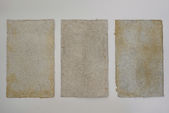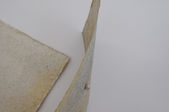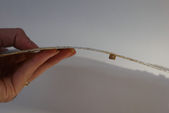MAGNETIC DUST, 2025
Brooklyn, new York
Gabriela Mestriner
Material practice is at the heart of how I think and create. Through hands-on experimentation with waste, natural elements, and overlooked residues — such as steel dust, wood shavings, and dried leaves — I explore how matter can carry meaning. These studies unfold as both process and proposition: tactile research into the sensory, symbolic, and environmental dimensions of materials. The magnetic paper series, rust-induced pigmentation, and recycled pulp experiments all reflect an evolving approach where making becomes a method of investigation.

A series of experimental papers were developed using waste materials collected from Pratt's fabrication labs. The primary compositions include steel dust from the metal shop, wood dust from the woodshop, and dried leaves gathered from the surrounding environment. Among these, one key outcome was a magnetic paper made by combining recycled white paper pulp with a high concentration of fine steel dust. The deep, rust-toned color and surface variation of this sheet emerged entirely from the steel particles embedded within it — no dyes or pigments were used. As the metal oxidized, it created rich textures and evolving hues, turning the paper into a living material. All papers were crafted through a hand-pulled papermaking process, resulting in flexible, textured surfaces that retain a soft touch while expressing the rawness of their source materials. Each sheet becomes a record of place and transformation, turning fabrication waste into meaningful matter with potential across design, craft, and storytelling.
This project reclaims steel dust — a byproduct of cutting and grinding metal — to produce a series of handmade papers with magnetic properties. Composed entirely of recycled white paper pulp and fine steel residue collected from Pratt Institute's fabrication labs, the resulting sheets are shaped through a process of sifting, blending, and hand-pulling — transforming industrial waste into a new material language.
The color of the paper is not added, but born of its own chemistry: a warm, earthy tone that emerges from the natural oxidation of the embedded steel — a living rust that stains the fibers from within. The magnetism, too, was not engineered but discovered — a response that shifted the project from technical recovery to material provocation.
Contrary to their delicate appearance, the papers are surprisingly flexible and resilient. As they attract small metal fragments, they become more than surfaces — they are memory devices, holding the trace of labor, process, and place. Rather than seeking traditional utility, the work invites reflection on the overlooked: what is considered waste, what holds value, and how design can honor material.
Magnetic Dust, 2025








